
About UsThe Numismatic Bibliomania Society is a non-profit organization promoting numismatic literature. For more information please see our web site at coinbooks.org SubscriptionsThose wishing to become new E-Sylum subscribers (or wishing to Unsubscribe) can go to the following web page link MembershipThere is a membership application available on the web site Membership Application To join, print the application and return it with your check to the address printed on the application. Membership is only $15 to addresses in the U.S., $20 for First Class mail, and $25 elsewhere. For those without web access, write to: David M. Sundman, Secretary/TreasurerNumismatic Bibliomania
Society AsylumFor Asylum mailing address changes and other membership questions, contact David at this email address: dsundman@LittletonCoin.com SubmissionsTo submit items for publication in The E-Sylum, just Reply to this message, or write to the Editor at this address: whomren@coinlibrary.com
BUY THE BOOK BEFORE THE COINYou won't regret it! |
- WAYNE'S WORDS: THE E-SYLUM AUGUST 22, 2010
- MORE ON NBS ACTIVITIES AT THE 2010 BOSTON ANA CONVENTION
- KOLBE & FANNING SALE 117/118 CATALOGS AVAILABLE
- NEW BOOK: THE SILVER COINS OF MASSACHUSETTS
- NEW BOOK: COINAGE OF THE CARAVAN KINGDOMS
- NEW BOOKS: FOUR NEW TITLES IN GEORGES DEPEYROT'S MONETA SERIES
- NEW BOOK AND EXHIBIT: MONEY ON PAPER
- BOOK REVIEW: MEDALLIC PORTRAITS OF ADMIRAL VERNON
- BOOK REVIEW: A GUIDE BOOK OF MODERN UNITED STATES PROOF COIN SETS, 2ND EDITION
- COIN CHEMISTRY REFERENCE BY GERHARD WELTER
- ANOTHER COIN BOOK WITH AN ENCASED COIN OR MEDAL
- BOOKBINDER RECOMMENDATION: THE OHIO BOOKSTORE
- BANKNOTE FIRM PATENTED GERMICIDAL AND RADIOACTIVE PAPER
- QUERY: PRICED CHAPMAN GEARY SALE SOUGHT
- QUERY: DAVID RITTENHOUSE MINT MEDAL INFORMATION SOUGHT
- RUSS SEARS VISITS MARYLAND MEDAL MAKER J. JENKINS SONS
- THE ROOSEVELT UNIVERSITY COURSE IN NUMISMATICS
- U.S. MINT UNVEILS NEW LOGO AND MARKETING CAMPAIGN
- WORKS BY MONEY ARTIST J.S.G. BOGGS EXBITED IN BEIJING
- 25 CENT TAOM RIVER ROADHOUSE MILITARY SCRIP OF 1943
- NOTES FROM E-SYLUM READERS: AUGUST 22, 2010
- OFFICIAL CLARIFICATION ON ANA CONVENTIONS
- WAYNE'S NUMISMATIC DIARY: AUGUST 22, 2010
- ANOTHER “GROUSE HUNT”: 1665 HENRY FAIRFAX MEDAL SOUGHT
- ARTICLE PROFILES U.S. MINT ARTIST SUSAN GAMBLE
- DEALER FENTON RECOVERS COIN STOLEN TEN YEARS AGO
- ARTICLE PROFILES 1881 CHOW BENT BATTLE MEDAL AWARDEE
- FEATURED WEB SITE: SYCEE ON-LINE
WAYNE'S WORDS: THE E-SYLUM AUGUST 22, 2010

Among our new subscribers this week are Elaine Rentz of Littleton Coin Company, Muriel Eymery and Al Raddi, courtesy of John and Nancy Wilson, Robert P Puddester, Seth Wilson, and Cliff Dube. Welcome aboard! We now have 1,367 subscribers.
This week we open with a report on NBS activities at last week's ANA convention followed by notes on the catalogs for the upcoming Kolbe & Fanning literature sales. Next, we have announcements of SEVEN new numismatic books, and new reviews of two.
Other topics include Welter's book on coin chemistry and preservation, books on the Royal Canadian Mint, the Roosevelt University course in numisamtics, and a visit to a medal maker in Maryland.
To learn about the Taom River Roadhouse script, and germicidal and radioactive banknote paper, read on. Have a great week, everyone!
Wayne Homren
Numismatic Bibliomania Society
MORE ON NBS ACTIVITIES AT THE 2010 BOSTON ANA CONVENTION
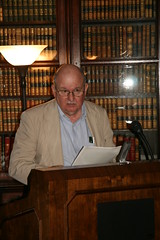
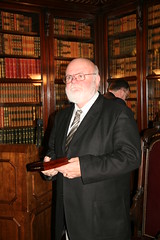
The NBS Symposium was the first of four NBS events at the Boston ANA. John W. Adams spoke to a full house on his recently-released book: The Medallic Portraits of Admiral Vernon/Medals Sometimes Lie. A copy of the book was signed by all in attendance and later, to complete a virtuous cycle, was auctioned to raise $5000 for the Club.
Lacking both our president and our vice-president, the Board meeting pushed most items forward but did renew the Club's commitment to YN scholarships. The regular meeting, another full house, with this one held in the awe-inspiring Dowse Library of the Massachusetts Historical Society, was riveted by Frank Campbell's biographical sketch which, for those who missed it, will be published in The Asylum.
The meeting, after the customary auction, adjourned by Treasurer and meeting chair David Sundman to view an unforgettable 10 case exhibit of some of the Society's numismatic treasures - all kudos to Anne Bentley for its design and execution.
Later, the NBS Board and invited guests boarded a bus to take them to fabled The Country Club, where a gourmet dinner put everyone in the perfect mood to "roast" our founder, George Kolbe. Toastmaster Joel Orosz was signed to a lifetime contract.
Dan Hamelberg and a small cabal created a lovely 10 ounce silver medal, the George F. Kolbe Lifetime Achievement Award. They then proceeded to award inscribed medal #1 to George and #2 to me. Marc Ricard designed the obverse and his dad the reverse.
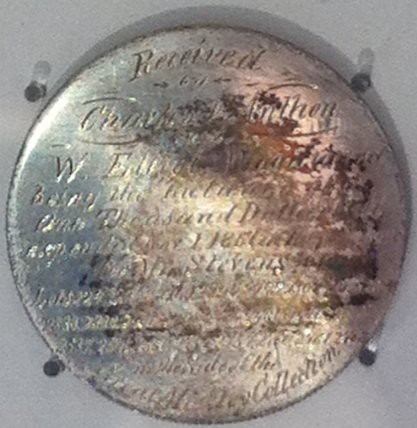
Alan Weinberg writes:
It's an 1867 Seated Liberty dollar pulled from circulation that year - thus likely mint state. The reverse was planed off and hand-engraved in script profoundly well, celebrating Charles Anthon's apparent $1000 total purchase level at the 1867 Woodward auction of the Joseph Mickley coin collection. It was given to Anthon, presumably by dealer Woodward, as Anthon's change from the $1000 purchase, and so engraved ( presumably by Woodward's jeweler) to commemorate the extensive Anthon auction purchases at the sale. That's how I interpreted the minute but readable engraved script.
You can easily read "Charles Anthon" and "W. Elliot Woodward" in the top several lines and "Great Mickley Collection" at the bottom curve. The central engraving was readable behind the case glass but is obscured in the photo by toning. Still, it is a remarkable image taken with a cellphone through glass from about two feet away and enlarged.
It's a credit to MHS curator Anne Bentley (assisted by Boston-area collector/author John Adams) that this unique and obscure historical numismatic item was selected from MHS' multi-thousand piece collection to exhibit alongside rare early medals and coins for the special occasion of the Boston ANA. Undoubtedly, they recognized its "special appeal" to collectors.
Anne Bentley adds:
I'd like to remind folks who will be in our neighborhood between now and October 2 that it's not too late to visit the Massachusetts Historical Society to see the show.
To read the earlier E-Sylum article, see: NBS ACTIVITIES AT THE 2010 BOSTON ANA CONVENTION (www.coinbooks.org/esylum_v13n33a02.html)
KOLBE & FANNING SALE 117/118 CATALOGS AVAILABLE
Two catalogs arrived in the mail this week, and by now many of our readers should have their copies as well - the 117th and 118th sales of Kolbe & Fanning.

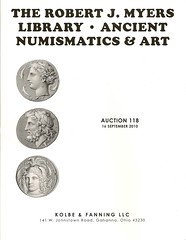
Below are some excerpts from sale #118, an essay titled "A Numismatic Life" by the consignor, Robert J. Myers.
My career as a numismatist had an unlikely beginning in an atypical setting. One day, at the age of 13, while living with my folks in Grand Rapids, Michigan, I visited an elderly widower. He had a box of old coins and eagerly sat with me relating their stories. On that day I bought my first ancient coin, a bronze of Augustus, and paid less than a dollar for it. To put things into perspective, at that time bus rides were a nickel. With that coin of Augustus I was hooked, found a Grand Rapids coin club and joined immediately.
Fast forward through marriage and fatherhood, which left neither time nor money for academic pursuits. Still, though I couldn't afford the best, I continued buying coins – mostly ancient and a few foreign. I returned to college later in life with two children to support, not much money and lots of coins. To support ourselves, another student and I opened a stamp (his specialty) and coin shop. It was my good fortune to be the only person in a 100 mile radius to be offering ancient and foreign coins. I also started buying books on the field and left Indiana University with more books on ancient coins than on biochemistry, which was my specialty.
Because of my expertise in bio-lab work (and the fact that they had a newly acquired, very expensive electron microscope no one on staff knew how to use) Cornell Medical College brought me to New York, where I did medical research until the mid 1970s when the projects' grants ran out. Cornell then hired me into hospital administration, which did not suit the scientist in me and I left.
When I first moved to New York I'd met Aaron Feldman. We became friends and I followed, almost religiously, his axiom, “Buy the Book before the Coin”. Thus, all during my hospital stint, I'd been building bookshelves in my railroad flat apartment and adding to my library. The sources, mostly European and American auctions and dealers, were international. In this period I began utilizing (and purchasing from) the fine catalogues and auctions of George Frederick Kolbe.
I now had the library (thanks, Aaron), a few coins and a great interest in antiquities so began buying and selling both. Thus I followed the adage that one should find something one loves and figure out how to make a living from it. I was then officially in the ancient coin and antiquities business. Timing was perfect. The business was flourishing.
Since I had the genesis of a good library, I started cataloging for other clients then decided to hold my own auctions. It never occurred to me to hire an auctioneer (probably a throw-back to the off-Broadway acting I did while at the hospital) so I obtained an auctioneer's license. As an aside, that license opened another aspect of my career as I was later hired as auctioneer for several American and European firms. Calling auctions in three languages in Switzerland was quite the challenge.
For more information, see: www.numislit.com
NEW BOOK: THE SILVER COINS OF MASSACHUSETTS
The Silver Coins of Massachusetts by Christopher J. Salmon (2010)
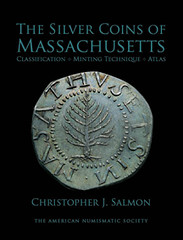 Hardcover, full color
Hardcover, full color
ISBN-13: 978-0-89722-316-0
ISBN-10: 0-89722-316
List Price: $95
Pre-order Price: $60
SPECIAL PRE-ORDER PRICE ON ORDERS PLACED THROUGH OCTOBER 15TH 2010
The silver coins of Massachusetts hold a special place in early American numismatics. They were the first coins struck in British North America, a mere generation after the establishment of the Massachusetts Bay Colony. Because of their historical importance and charming style, they have prompted rich inquiry among scholars and an intense interest and desire among collectors.
The Silver Coins of Massachusetts is a splendidly illustrated review of these coins, employing the latest historical and numismatic evidence as well as novel scientific analysis. Minting technique is explored in detail. All varieties of the coinage are newly classified with a consistent yet flexible taxonomic system that lists the varieties in chronological order and can readily accommodate potential future discoveries. The system allows an appreciation for how varieties evolved and the relative degree of change that occurred at each step. It is designed to be as simple as possible without oversimplifying, with all varieties named according to their obverse and reverse dies.
The book includes a fully illustrated atlas that details important characteristic features. The last part of the atlas displays each variety at actual size to aid in attribution.
$60 pre-order discount if ordered by or on October 15th, 2010
For more information, see: (www.numismatics.org/Store/MassSilver)
I am a subscriber to your excellent newsletter and always look forward to receiving it with great eagerness and anticipation! I generally read it from start to finish.
I have attached a biographical paragraph that is slightly modified from the biography that will appear on the back flap of the dust jacket.
I greatly appreciate your interest in the upcoming book about Massachusetts silver coins. I am very excited about this project, and can tell you that it will be a sumptuous production with 157 gsm art paper and hundreds of color illustrations, a new classification system, and original research.
Christopher J. Salmon, M.D. is a radiologist in private practice in Scottsdale, Arizona. A former National Institutes of Health Research Fellow at the University of California, San Francisco, he was Director of Thoracic Imaging at Brown University and then Director of Thoracic Imaging at Oregon Health & Science University. He has written articles in the medical scientific literature and has been a contributing author in several medical textbooks. He is an enthusiastic collector, bibliophile and student in a wide variety of areas including American and ancient coins, early Americana, Greek and Roman art, music, and the history of science. This is his first numismatic book.
NEW BOOK: COINAGE OF THE CARAVAN KINGDOMS
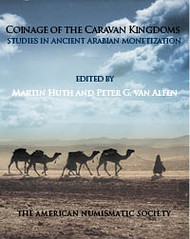 Coinage of the Caravan Kingdoms - Studies in Ancient Arabian Monetization by Martin Huth and Peter G. van Alfen (2010)
Coinage of the Caravan Kingdoms - Studies in Ancient Arabian Monetization by Martin Huth and Peter G. van Alfen (2010)
List: $185
Pre-publication price: $100 (through 10/15/2010)
Hardback
ISBN-13: 978-0-89722-312-6
This volume represents the first comprehensive look at ancient Arabian coinage in toto since George Hill's 1922 British Museum catalogue. In addition to a catalogue and updated typologies of Philistian, Nabataean, Minaen, Qatabanian, Sabaean, Himyarite, and Gerrhean coinages, among others, and die studies of the owl and Alexander imitations, this volume features essays written by numismatist, archaeologists, and epigraphists that situate the coins within their political, social, and economic contexts. As these studies demonstrate, the beginnings of coinage in Arabia followed two very distinct traditions, the first along a line running roughly from Gaza on the Mediterranean coast to the Hadhramawt on the Arabian Sea, the other in eastern Arabia, running along the Persian Gulf coast from the mouth of the Euphrates to the Oman peninsula.
For more information, see: Megan Fenselau also forwarded this information about another new book from the American Numismatic Society. Thanks! (www.numismatics.org/Store/CCK)
NEW BOOKS: FOUR NEW TITLES IN GEORGES DEPEYROT'S MONETA SERIES
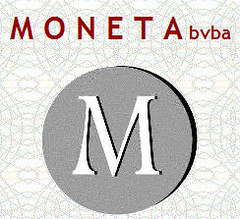 Four new volumes are in press in the Moneta series:
Four new volumes are in press in the Moneta series:
#110, A. Šemrov, Die Fundmünzen Der Römischen Zeit in Slowenien, Band VI, 332 pages ISBN 978-90-77297-78-0
#111, J.-L. Dengis, Trouvailles et trésors monétaires en Belgique, V. Province du Brabant et les trouvailles belges non localisées, 168 pages ISBN 978-90-77297-80-3
#112, M. Tsotselia, Coin finds in Georgia (6th century BC – 15th century AD), 2010, 430 pages ISBN 978-90-77297-79-7 #113, R. Abdy, Ed. Besly & F. López-Sánchez, The Gloucester Hoard and other coin hoards of the Britannic Empire, Coin hoards from Roman Britain XIII, 280 pages
These volumes will be available in October.
The volume # 114 is in preparation E. Petac, Aspecte ale circula iei monetare în Dacia Roman (106-275 p. Chr.) (in Romanian with French abstract)
For more information, see: www.moneta.be
THE BOOK BAZARRE
NEW BOOK AND EXHIBIT: MONEY ON PAPER
Exhibit of Paper Money
Princeton University, August 30, 2010, to January 2, 2011
Paper money as a form of art might seem the makings of a rather small exhibition, to judge from the modern bills of the United States and Europe. Bank notes, however, have constituted one of the dominant forms of visual communication for the past two centuries, and in many cases can be seen as works of art in their own right. Princeton University's Numismatic Collection is featuring currency worth looking at in the exhibition "Money on Paper: Bank Notes and Related Graphic Arts from the Collections of Vsevolod Onyshkevych and Princeton University," on view in the Leonard L. Milberg Gallery for the Graphic Arts, Firestone Library, Princeton University, August 30, 2010, through January 2, 2011.
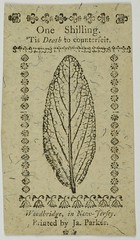 Because British colonial policies resulted in a dearth of circulating coins, the American colonies were the home of the earliest regular issues of paper money. Illustration was applied to colonial currency as an anti-counterfeiting device as well as for aesthetic purposes. Not surprisingly, the most inventive printer of paper money of the time was Benjamin Franklin, who devised a system of transferring the vein patterns of tree leaves to printing plates to foil counterfeiters. The Princeton exhibition includes a large selection of Franklin's nature-print notes, as well as issues of Paul Revere and the South Carolina engraver Thomas Coram, who brought classical imagery to that colony's bank notes.
Because British colonial policies resulted in a dearth of circulating coins, the American colonies were the home of the earliest regular issues of paper money. Illustration was applied to colonial currency as an anti-counterfeiting device as well as for aesthetic purposes. Not surprisingly, the most inventive printer of paper money of the time was Benjamin Franklin, who devised a system of transferring the vein patterns of tree leaves to printing plates to foil counterfeiters. The Princeton exhibition includes a large selection of Franklin's nature-print notes, as well as issues of Paul Revere and the South Carolina engraver Thomas Coram, who brought classical imagery to that colony's bank notes.
One of the highlights of the exhibit will be the first public display of the recently discovered banknote engraving of a grouse by John James Audubon, the great wildlife illustrator's first published work. On display with a sample sheet containing the vignette will be an original watercolor by Audubon, a steel printing plate from The Birds of America, and the Princeton first edition of the elephant folio book open to the page with Audubon's drawing of the pinnated grouse.
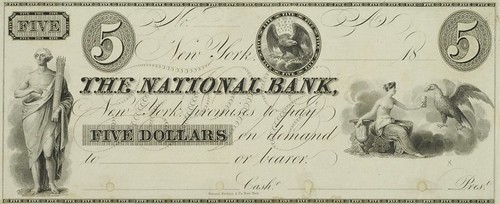
Asher B. Durand, one of America's greatest painters, was also a major figure in the development of bank note art in this country. Along with his brother Cyrus, who invented a highly decorative series of anti-counterfeiting devices, he developed a classical, patriotic approach to bank note design that dominated the medium for the first half of the nineteenth century.

A section of the Princeton exhibit will explore the divergence of imagery on the bank notes of northern and southern issuers before and during the Civil War. Collectors of paper money will be especially interested by the complete set, in Extremely Fine condition, of six notes printed by the National Bank Note Company in New York and smuggled into the Confederacy in 1861 for distribution as notes of Montgomery, Alabama, and Richmond, Virginia. The American section of the exhibition ends with the high point of American bank note art, the Educational Series of 1896, designed and engraved by some of the most important illustrators of the day.

The stagnation of American paper money design in the twentieth and twenty-first centuries is put into relief by comparison with some of the beautiful and creative examples of European notes, on loan for the exhibition from the collection of Vsevolod Onyshkevych, Princeton Class of 1983. Alfons Mucha, the popular creator of poster art, designed paper money for Czechoslovakia in the 1920s that epitomizes the glory of art nouveau design.
Other important artists of the period, such as Emile Vloors in Belgium and Eliel Saarinen in Finland, put their stamp on the currency of the period. In the second half of the twentieth century, R. D. E. Oxenaar and J. T. G. Drupsteen created a distinctive look for the bank notes of the Netherlands. In the era since the euro imposed a bureaucratic sameness to the currency of most of Europe, Switzerland has kept the innovative look of its paper money with the computer-enhanced colorful notes designed by Jörg Zintzmeyer, while the Faroe Islands have issued a series of simple, evocative notes based on the watercolors of Zacharias Heinesen.
A publication entitled Money on Paper, by Princeton's Curator of Numismatics Alan M. Stahl, accompanies the exhibit. It contains a full catalogue of the bank notes on display with color photographs of many of them. There are three additional illustrated essays in the catalogue: Mark Tomasko writing on "Bank Note Engraving in the United States," Francis Musella on "Benjamin Franklin's Nature Printing on Bank Notes," and an edited version of the newsmaking article by Robert Peck and Eric P. Newman entitled "Discovered! The First Engraving of an Audubon Bird." The book is available for $40 from the Friends of Princeton University Library, One Washington Road, Princeton, NJ 08544. Inquiries about ordering can be made to Linda Oliveira at loliveir@princeton.edu or at (609) 258-3155.
In a public lecture on Sunday, October 17, at 3 p.m. in McCormick Hall 101, Mark D. Tomasko, a well-known expert on paper money, will speak on "The Art of Bank Note Engraving." The lecture, open to the public without charge, will be followed by a reception in Firestone Library and a curatorial tour of the exhibition. Additional curatorial tours will be held on Sunday, November 22, and Sunday, December 12, both at 3 p.m.
"Money on Paper" runs from August 30, 2010, through January 2, 2011, in the Leonard L. Milberg Gallery of Firestone Library, Princeton University. Hours are Monday through Friday, 9 a.m. to 5 p.m., Saturday and Sunday, noon to 5 p.m., closed holidays. Further information can be obtained from Alan Stahl, Curator of Numismatics at astahl@princeton.edu or (609) 258-9127.
BOOK REVIEW: MEDALLIC PORTRAITS OF ADMIRAL VERNON
 Of the several speeches I attended at the Boston ANA Convention the most notable one was delivered by John Adams on his and senior Fernando Chao's new book. Medallic Portraits of Admiral Vernon. I was familiar with this series since 1951, when I had met the greatest collector of this series, Leander McCormick-Goodhart, and later acquired the issue of Stack's brief serial publication, Numismatic Review, which contained M-G's catalog listing of this series. (He had amassed over 10,000 of these pieces with about 1,000 different.)
Of the several speeches I attended at the Boston ANA Convention the most notable one was delivered by John Adams on his and senior Fernando Chao's new book. Medallic Portraits of Admiral Vernon. I was familiar with this series since 1951, when I had met the greatest collector of this series, Leander McCormick-Goodhart, and later acquired the issue of Stack's brief serial publication, Numismatic Review, which contained M-G's catalog listing of this series. (He had amassed over 10,000 of these pieces with about 1,000 different.)
The present authors have brought this series into sharp focus, in contrast to many of the specimens which are often obscure, difficult to identify, or sheer vagueness of design or devices. The authors should be commended for recognizing portraits that are almost blobs of metal (technically a boss) and identifying devices that are often indistinct. Lesser numismatists would have given up in despair over such frustrating cataloging endeavors. Fortunately, the legends were more easily transcribed, which the authors have performed with amazing accuracy.
The cataloging numbering system is unique and the cataloging format is new and ideal. I must admit I am a cataloging numbering system and format freak. I like to study these for their usefulness and possible adaptation to other series. The catalog numbering system for this series, however, will remain unique to this series alone. Each catalog number contains three elements: location (in capital letters), who is portrayed (in lowercase letters), and a serial number-letter (number-hyphen-letter) identifying the specific variety.
The format on the other hand can serve as a model for future numismatic works. The catalog number is centered in black with a red line (printers call that a rule) over and under the number. Obverse photo to the left, reverse photo to the right, with pertinent data listed between: size, composition, rarity, type, source of photo.
Under each photo is first legend, flagged in red, delineated in bold type, then a description, noted as "devices" also in red. Below are comments and additional data of any kind applicable to that variety. Generally two such medals are displayed and described per page in this uniform arrangement. It makes for very easy reading and reference.
The early chapter on "history of the events" -- written by collaborator Anne E. Bentley -- places all these specimens in historical perspective.
I was also in admiration of the appendices. Here is the collector lore that is so desirable by numismatists. We find: data on metals, engravers, concordances with previous listings, sources of images from public collections, census, collectors and collections, plus a discourse on grading these pieces. Great charts and data in all. And finally, an extensive bibliography.
The authors have covered the subject so thoroughly that little could be added. The book answers any question a collector could ask of this series. While it has taken two centuries of their existence for this book to appear, it might take another century for a second or subsequent book to add anything not in the present work.
The two authors have never met in person. They expect to shortly as Dr. Chao visits America to meet with John Adams. Wouldn't you like to be a fly on the wall for those conversations!
What is not answered in the book is this one question: What is the meaning of the "(h)" after Dr. Fernando Chao's name every time it is used? I had the opportunity to ask that of speaker Adams during Q&A following his talk. It means "junior" -- for the word in Spanish. Frank Campbell, former ANS librarian who was seated in front of me, turned around and repeated the word to me with amplified meaning.
Well if Dr. Chao can have a letter after his name, I proposed a letter after John Adams' name. That letter should be "A+" -- his grade for the present work!
Dick Doty offers one possible improvement. He writes:
I only wish John Adams had included information on manufacturers of Vernon medals. Are they ever punch-linked to other medallic pieces or counterfeit regal coppers? I have a hunch they are. Are they all from London, or were many struck elsewhere (e.g., Birmingham, Bristol)? The author's rendered Numismatics a considerable service to be sure. But there's still a ways to go before we can really understand this series.
To read an earlier E-Sylum review (with ordering information), see: BOOK REVIEW: MEDALLIC PORTRAITS OF ADMIRAL VERNON (www.coinbooks.org/esylum_v13n33a05.html)
BOOK REVIEW: A GUIDE BOOK OF MODERN UNITED STATES PROOF COIN SETS, 2ND EDITION
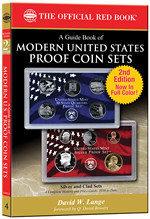 The Official Red Book, A Guide Book of Modern United States Proof Coin Sets 2nd Edition, by David W. Lange, with Foreword by Q. David Bowers
The Official Red Book, A Guide Book of Modern United States Proof Coin Sets 2nd Edition, by David W. Lange, with Foreword by Q. David Bowers
The Official Red Book, A Guide Book of Modern United States Proof Coin Sets, 2nd Edition, by David W. Lange is updated from the 1st Edition and is now in vivid color. It covers thoroughly this interesting and highly collected series. The reference covers silver and clad sets starting in 1936. Of importance to many new collectors would be the 50 State Quarters Proof Sets which started in 1999.
Nancy started collecting these sets in 1950 and got them from the mint every year thereafter. She never realized the complexity of the series and merely, especially in the early years, just got sets on a yearly basis and ignored the varieties. After we got married in 1968, we continued to collect the sets.
In this second edition, David does an excellent job of giving details by year along with pictures of all the coins for that year with values in the most appropriate grades for that year. The certified populations are also given for each coin in each of the grades. All the pictures are in beautiful color.
The detailed commentary in each year is especially complete and discusses how the sets were packaged and how that packaging treated the coins over the years. The many finishes are described and discussed as to rarity for each particular year.
In the beginning of the book, David gives a short history of proof sets as well as the collecting and storage of the sets. This information will help the beginning as well as advanced collector. At the end of the book, he has a “Gallery of Early U.S. Proof Coins” from 1802 to 1921 with beautiful pictures of each of the coins.
After reading this book, we have a new appreciation of the series and now realize the possibility of finding rare and valuable pieces in our accumulation of yearly sets. I feel most collectors will find this book both enlightening and interesting.
This soft cover book contains 256 pages and is available from Whitman for $19.95. They can be contacted at: Whitman Publishing, LLC, 3103 Clairmont Rd., Suite B, Atlanta, GA, 30329 or phone (800) 546-2995 or visit their web page at www.whitmanbooks.com .
COIN CHEMISTRY REFERENCE BY GERHARD WELTER
In response to Warner Talso's earlier question, Peter Gaspar writes:
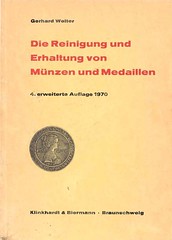 Warner Talso asked for recommendations of book on the chemistry of coins. You cited Weimar White's book, and while I can't find my copy, and thus don't want to offer criticism of it, my recollection is that I did not find it useful.
Warner Talso asked for recommendations of book on the chemistry of coins. You cited Weimar White's book, and while I can't find my copy, and thus don't want to offer criticism of it, my recollection is that I did not find it useful.
There are very few single volumes on the deterioration of coinage alloys and their conservation. The one I can recommend with enthusiasm is also an oldie: Gerhard Welter, "Die Reinigung und Erhaltung von Muenzen und Medaillen" (The cleaning and conservation of coins and medals). I have the fourth expanded edition of 1970, published by Klinkhardt and Biermann in Braunschweig, Germany. There is an English translation published in the 70's by Hans Schulman but it is highly abridged, and I do not recommend it.
The German edition that I use is a 124 page paperback, just crammed with concisely presented information in its nine major sections and ca. eighty subsections. It begins with a description of coinage metals and their properties, then goes on to the changes that these metals and their alloys suffer over time, the cleaning of coins, the removal of corrosion products, various other techniques for the treatment of coins, and several further sections with topics such as protective coatings, how to make worn inscriptions visible, how to make plaster casts and other reproductions, coin photography, metal analysis, and authentication methods.
If one can read German Welter's book is a treasure. I don't know whether further editions were published.
To read the earlier E-Sylum article, see: QUERY: COIN CHEMISTRY REFERENCE SOUGHT (www.coinbooks.org/esylum_v13n32a14.html)
THE BOOK BAZARRE
A FEW UPCOMING SEPTEMBER 16, 2010 AUCTION HIGHLIGHTSThe First Twelve Catalogues Issued by Jacob Hirsch: Unique annotated sales copies, generally recording information about the coins in the sales and the collectors who acquired them that may be found nowhere else.
Also Featuring Hirsch's Ars Classica sales devoted to ancient coins and other key coin and medal sales, including Rhousopoulos, Weber I & II, and Löbbecke.
(614) 414-0855 • df@numislit.com • GFK@numislit.com
ANOTHER COIN BOOK WITH AN ENCASED COIN OR MEDAL
I thought I'd add something to the discussion on books with an embedded coin or medal. The Royal Canadian Mint celebrated its hundredth anniversary in 2008. The Mint celebrated this milestone starting with the 2003 issue of the Mint's Annual Reports. They were sold with coins embedded in the cover. I attached a photo of the 2003 edition with a gold-highlighted cent.
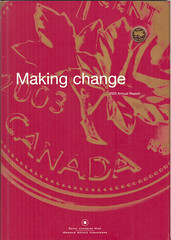
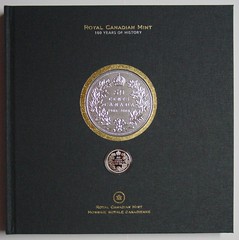
The practice was continued until the 2006 edition. Being government documents, Annual Reports are usually free. Although the above issues were not free, they were available for download as PDFs at no charge. As with many Canadian government documents, they are bilingual, with the French text tete-beche. For each year, there are editions with the coin embedded into the French cover rather than the English, meaning there are two varieties for each year.
The issue culminated with the 2008 publication of Royal Canadian Mint 100 Years of History. An encapsulated half-dollar was inserted into the cover. Unlike with the Annual Reports, this coin can be removed and reinserted. Of course, a French edition was also available.
To read the earlier E-Sylum article, see: MORE BOOKS WITH AN ENCASED COIN OR MEDAL (www.coinbooks.org/esylum_v13n32a11.html)
BOOKBINDER RECOMMENDATION: THE OHIO BOOKSTORE
I have another recommendation for leather bindings. I have been using the Ohio Bookstore in Cincinnati, OH for many years. They do a wonderful job and are reasonably priced. The address is 726 Main Street, Cincinnati, OH 45202. Phone number is 513.621.7941 and website is ohiobookstore.net.
Many collectors have seen copies of my books bound in leather by them at past ANA conventions and they recently bound the half dime book sold at the JRCS meeting which was passed around at other meetings. They also did the official leather binding for the half dime book commissioned by Russ Logan and the leather on the Peterson half dollar book is also from them.
They will also be binding the special editions of the upcoming Browning Quarter book update that Rory Rea, Dr. Glenn Peterson, John Kovach and I have been working on the last few years which will be available early next year.
BANKNOTE FIRM PATENTED GERMICIDAL AND RADIOACTIVE PAPER
Andrew Hurle of Australia writes:
Those who read the story in the recent E-Sylum about germs and money may also be interested to know of DeLaRue's long-standing recognition of the importance of numismatic hygiene. In 1937 the company patented a process to develop antiseptic banknotes that it claimed were “incapable of carrying infection”.
I'm not sure what prompted such an innovative leap forward but their patent application outlines a number of techniques designed to impregnate the paper fibres with a germicide during the manufacturing process. These include introducing the chemical during the pulp beating process; passing the web through a vapour chamber or applying it with the sizing. In each case the antiseptic (described here as being “intimately incorporated” into the paper) bears the rather formidable name: ‘methyl-hydroxy-tertiary-butyl-benzene'.
I can't comment on the potency of the compound as trying to find a layman's description on the the internet is a labyrinthine task but there is no mention in DeLaRue's application of the possible side effects of handling a chemically saturated substrate in such quantities as might concern the average shop-keeper or bank-clerk.
The company filed another substrate patent in 1962 - this time for a process that embedded a radioactive isotope into paper so as to identify and authenticate banknotes via an inimitable radioactive “signature”. Again, there's no mention of effects on the punter but the radioisotope proposed by DeLaRue in the patent is C14 - used in carbon dating to determine the age of plant and animal fossils and so I assume (as a non-chemist) that its effects were as benign as the company's good intentions.
If anyone would like to follow up, the relevant patent numbers are: 467,664 (antiseptic banknotes) and 990,256 (radioactive banknotes).
To read the earlier E-Sylum article, see: DIRTY MONEY: BANKNOTES REFLECT NATIONAL WEALTH (www.coinbooks.org/esylum_v13n33a23.html)
QUERY: PRICED CHAPMAN GEARY SALE SOUGHT
I was wondering if you or any of the Esylum readers could help me with a catalogue inquiry. I recently acquired an envelope that was sent by R. W. Geary (of Canada) to S.H. & H. Chapman in 1897. The envelope had $1.30 written on the back in a way that I have noticed the Chapman's usually recorded how much and from whom money was received. The date on the envelope is Dec 27, 1897.
In the S.H. & H. Chapman sale of December 13, 1897 Lot 640 is described as "BUTTON Montreal British Militia. Good. Very Rare." Since Geary was not only a Canadian numismatist but an expert on military buttons (as well as the War of 1812) I am curious if anyone has a priced catalogue of this sale. Since a Side View token (there were five in this sale) would likely have sold for more than a $1.30 even then, I wonder if a price on Lot 640 may satisfy my curiosity that this is indeed what Geary won in the auction.
As always thank you for your tireless efforts in bringing the Esylum to us all every week. I can appreciate the amount of work involved and although I realize you love to do it, it can still be hard to accomplish weekly as life invariably gets in the way!!
QUERY: DAVID RITTENHOUSE MINT MEDAL INFORMATION SOUGHT
Ron Ward writes:
I was totally unaware of the Rittenhouse Society until I read the report of their recent meeting. This brought to mind the David Rittenhouse Mint Medal (MT-1) that I purchased several years ago. It appears to be an early striking, but is silver-plated. Can anyone shed light upon this example?
To read the earlier E-Sylum article, see: THE RITTENHOUSE SOCIETY MEETING AT THE 2010 BOSTON ANA CONVENTION (www.coinbooks.org/esylum_v13n33a08.html)
RUSS SEARS VISITS MARYLAND MEDAL MAKER J. JENKINS SONS
Recently, I purchased a Johns Hopkins Alumna medal which I had never seen. The Alumnus medals are pretty common, but the Alumna was new to me. I called the Johns Hopkins University Alumni Association and asked about the medal. They were not able to tell me very much about it but referred me to their vendor for more information.
I called Mark Wenderoth at J. Jenkins Sons Co. Inc. and found out that the Alumna medal was made to be given to woman graduates, fifty years after graduation. It has been in use for about 15 years. Of course I was interested in what medal maker produces the medals. I assumed they were the middle man.
Mark told me that they make the medal here in Woodlawn, Baltimore County, Maryland. Having been a Baltimore medal collector for almost 30 years, I was surprised that we have a medal maker in Baltimore. Mark agreed to give me and some friends a tour of his plant which is primarily in the business of making school rings, but makes numerous other items.
On August 17, we visited the plant with Mark as our guide. He did a great job of showing us their operations and explaining the steps in manufacturing. We not only saw the medal making process but also the school ring manufacturing which uses the lost wax cast process which goes back to the Egyptians.
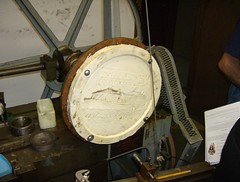

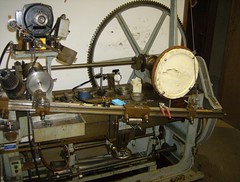
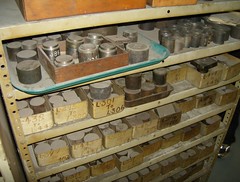
To view a slide show of all images, see: J. Jenkins Sons Co. Inc. (www.flickr.com/photos/coinbooks/sets/72157624763945420/show/)
THE ROOSEVELT UNIVERSITY COURSE IN NUMISMATICS
The Roosevelt University courses were conceived and fostered by Arthur Kagin. My files show that at least 53 prominent numismatists were involved as consultants and teachers. Arthur was persuasive and got all the “name” people to participate in one way or another. His objective was to make Numismatics an accredited college course.
The First Seminar, part of Roosevelt University's Division of Continuing Education program, was held in Chicago September 29-December 15, 1965. The second Semester was February 16-May 18, 1966. The course was titled “Numismatics The Story of Civilization”. First Seminar instructors included: George Fonda, Gilroy Roberts, Leland Howard, Kenneth Bressett, George Fuld, Leonard Stark, Margo Russell, J. Hewitt Judd, Joseph Segel, Matt Rothert, Grover Criswell, Bernard Feinberg and Charles Ricard.
Second Semester instructors were: Admiral Oscar Dodson, Eva Adams, Hans Schulman, John Davenport, Paul Kagin, John Jay Pittman, Eric Newman, Don Taxay, Richard Yeoman, Nate Shapero, Amon Carter, Nathan Eglit and Arthur Kagin.
A Special Numismatic Seminar entitled “Principles of Numismatics” was offered in Roosevelt's Fall Semester, October 1, 1966-January 5, 1967. Dr. and Mrs. Clain-Stefanelli, and William Pettit were billed as lecturers. I do not remember if that course was ever actually presented. And I have no information as to why the numismatic series was never continued. I have not seen the medal described by George Fuld, but as a participant I did receive the beautiful pure silver medal pictured here that was designed by Gilroy Roberts and struck at the Franklin Mint.

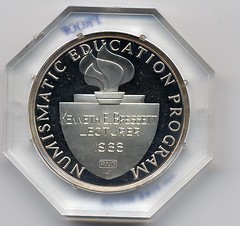
To read the complete article, see: QUERY: ROOSEVELT UNIVERSITY COURSE IN NUMISMATICS (www.coinbooks.org/esylum_v13n33a15.html)
THE BOOK BAZARRE
U.S. MINT UNVEILS NEW LOGO AND MARKETING CAMPAIGN
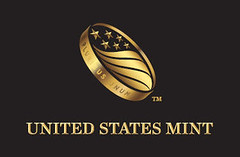 Established in 1792, the United States Mint is the world's largest coin maker, the sole authorized manufacturer of American coins and official medals, and the guardian of the nation's gold supply. Despite this long history and impressive heritage, the organization was faced with a general lack of understanding of its breadth of additional offerings, and, as a result, needed to strengthen its identity and level of awareness with the general public.
Established in 1792, the United States Mint is the world's largest coin maker, the sole authorized manufacturer of American coins and official medals, and the guardian of the nation's gold supply. Despite this long history and impressive heritage, the organization was faced with a general lack of understanding of its breadth of additional offerings, and, as a result, needed to strengthen its identity and level of awareness with the general public.
Additionally, the United States Mint aspired to increase sales of collectable coins, increase the uptake and use of dollar coins, and develop increased public awareness of the United States Mint as the only legal manufacturer of all American coins.
After an extensive audit into the current state of the United State Mint brand, as well as competitor and best practice organizations, we began by establishing a fresh brand promise for the United States Mint: Connecting America through Coins. Unique in its impressive footprint on a captive audience – most Americans have its products in their pocket at any given time – the United States Mint is involved at numerous touch points with Americans, whether they're using coins to teach children to count or flipping a quarter at the 50-yard line of a football game.
By presenting coins as part of the common language of America, as well as the lifeblood of commerce, the organization's new brand promise demonstrates the many stories and core values of America that unite us all.
An accompanying visual identity system brought the brand strategy to life, and also gave the United States Mint the level of sophistication necessary to fully live up to its heritage. The coin symbol, flipping in the air, embodies an optimistic spirit that is symbolic of core American values and the everyday commerce of our country.
The logo's craft and detail embody the artistic excellence the organization strives for in everything it produces, while the stars and stripes stand for the United States Mint's connection to the nation. Lastly, the stars represent the six United States Mint facilities, as well as America's six circulating coins.
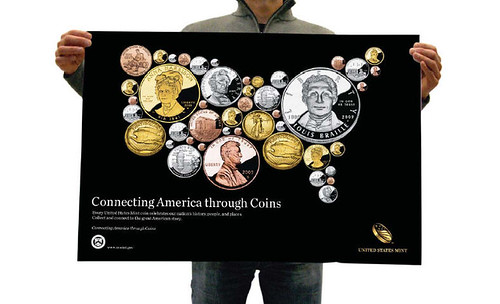
The "Connecting America Through Coins" theme is kind of lame too, but probably more workable. We'll see - time will tell if any of this clicks with the buying public.
I wrote this before I had a chance to look at this week's Coin World, and I see it was a front-page story. Beth Deisher's editorial was milder than my commentary, but she rightfully noted that "building a strong brand is more than rolling out a new logo. To be a top competitor, the U.S. Mint will have to "walk the walk" as well as "talk the talk." -Editor
To read the complete article, see: Connecting America through Coins (www.siegelgale.com/pdf/SG_CS_USMint_081310.pdf)
WORKS BY MONEY ARTIST J.S.G. BOGGS EXBITED IN BEIJING
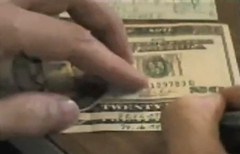 Under the banner Artistic Creativity, Artistic Life, the 2010 Beijing International Art Exposition will be held from August 19-23 at China World Trade Center, attracting over 100 top art agencies and galleries from home and abroad.
Under the banner Artistic Creativity, Artistic Life, the 2010 Beijing International Art Exposition will be held from August 19-23 at China World Trade Center, attracting over 100 top art agencies and galleries from home and abroad.
Now in its 13th year, the event will highlight quality art works of high collecting value, the organizer said.
The exposition will boast a collection of over 5,000 pieces of artwork from top-notch international galleries like Germany's Hagemann Gallery, Olga's Gallery in Switzerland and Boun/HuaMing Art Space from France.
A highlight of the show is the inclusion of signature pieces by J.S.G. Boggs, whose work deals with the tension between money's aesthetic value and its economic function.
A group of contemporary Italian artists will have their works shown for the first time in China at the exposition, including Gianfranco Meggiato, Antonello Venditti and Vincenzo Balsamo.
To cater to the demand for Western classical works in China, several impressionist pieces such as La Route de Verrières by French painter Alfred Sisley and Pond's Edge In Normandy by Jean-Baptiste-Camille Corot will be on display.
To view the video on YouTube, see: www.youtube.com/watch?v=gEtKSqzpj0Q .
25 CENT TAOM RIVER ROADHOUSE MILITARY SCRIP OF 1943
In the New Zealand Numismatic Journal of May-August 1953 the 'father' of numismatics in NZ, Allan Sutherland, reported some military scrip used in New Caledonia by American and New Zealand troops stationed there. He said that although the US dollar was the preferred currency (and NZ currency was in short supply) the YMCA at Taom River Roadhouse provided paper chits for the use of the troops.
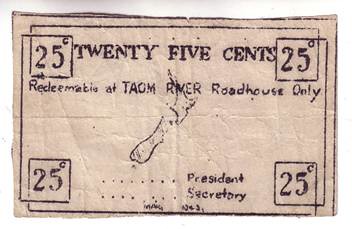
The notes he had were approximately 3½ inches by 2 inches, and there were 1 Cent and 5 Cent notes. These were, he presumed, duplicated on brown, white and cream duplicating paper, enclosed by ruled lines and cut out with scissors.
The 1 Cent note has ONE CENT separated by the figure one in a circle, and above is TAOM RIVER and below ROADHOUSE. The white 5 Cent note has a small drawing of five swimmers, two swimming to right, one diving in and one about to dive. The fifth looked on. The legend is REDEEMABLE AT TAOM RIVER ROADHOUSE ONLY with lines for signatures by the PRESIDENT and SECRETARY. Both notes are printed in black. Taom River is inland from Ouaco.
Now another specimen has emerged - a 25 Cent note. It is as illustrated, with a map of New Zealand in the centre, and the date MAY 1943 at the bottom. It measures 4 inches by 3 3/8 inches (or 101x61mm) and certainly looks to have been cut out with scissors. It is black on coarse aged white (or possibly cream) paper.
There is a 25c symbol in each corner. In the centre is a map of New Zealand, with TWENTY FIVE CENTS along the top and 'Redeemable at TAOM RIVER Roadhouse Only' across New Zealand's North Island, with dotted lines for 'President' and 'Secretary' signatures at the bottom. In small print is MAY 1943 near the bottom edge.
None of the sighted notes are signed, and there are no registration numbers. The writer would be delighted to hear from any collector who has more, or any, of these very scarce pieces.
In the same article Allan reported a card issue for Helavo Seaplane Base, and a paper issue in New Caledonia by NZ Divisional Signallers.
NOTES FROM E-SYLUM READERS: AUGUST 22, 2010
Tony Swicer of West Palm Beach, FL writes:
I attended the ANA in Boston working at the F.U.N. table. On Friday I went to the Boston Public Library and saw the Evacuation of Boston Gold medal that was presented to George Washington. This was the first showing of the medal in 130 years. It was not easy to find.
I asked at the information desk and they told me to take the elevator to the third floor and look for the rare books room. So after taking several wrong turns, I finally found the room. It was through a maze of other rooms.
The room was about 25' X 25', dark, and with one attendant at a computer. There in the middle of the room was a case about 5' X 3' and 4 foot tall with a glass top. In the bottom left of the case was the medal in a purple velvet box. Next to it was an 81/2” X 11” sheet with the pedigree of the medal. A novice looking at the medal would not know the significance of it. My best guess of the value is $1 to $2 million.
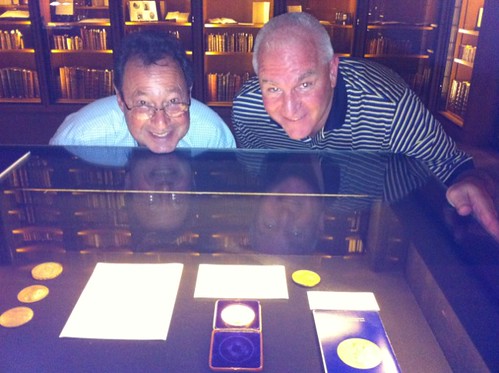
They also had a booklet for sale 31/2” X 81/2” with the medal on the front in gold on blue. The booklet was only $3 but you had to find the business office to buy the book. That was another adventure.
Tony Hine forwarded this link to the blog of bookdealer Brian Cassidy. Tony refered to him as a "Blogging bibliophile". See www.briancassidy.net .
Last week Fred Reed wrote:
You have a birthday coming up. Happy Birthday, and check out my The Week That Was column in the upcoming August 23rd issue of COIN WORLD.
My birthday is coming up August 24th. My son Tyler's 10th birthday was Friday, August 20th. We've been celebrating with family dinners, cake, and a coincidental family trip this weekend to Virginia Beach. I published this week's issue from our hotel.
Tom Kays writes:
Happy Birthday! Wow, I saw Fred Reed's list of memorable events in the current Coin World for August 24th. Your birth rates right up there with the Confederate government establishing an assay office at the mint in Georgia. Nineteen Fifty-Eight was a very good year. I may be away next week and I wanted to be the first to wish you well.
Have you read the news from the day you were born? The BBC has a good news archive and the World Book Encyclopedia used to publish annual supplements each year.
OFFICIAL CLARIFICATION ON ANA CONVENTIONS
ANA President Clifford Mishler responded to my hurried (and harried?) response to my comments in last week's E-Sylum on ANA conventions. Sorry if I misled anyone on the timing of the show in my comments. Here is Cliff's response:
"I would like, however, to call your attention to one point of error. The ANA is not 'adding a new Spring Show;' rather a fall show is being added to the sequence, on a trial basis that will hopefully prove beneficial to the community and the ANA over the long haul.
"This is an investment that the organization will be making in the welfare of the community, as the need has been viewed. Frankly, the spring NMS presentations have been only marginally profitable as they have been produced; those 'profits' are applied to benefit programs which it is hoped can be made to grow, which by their nature cannot be self-supporting. Presently, in my view, the ANA has two events, one a full-blown convention, the other being an event that is not much more than a substantial local coin show.
"The ANA's next spring show will be in Sacramento in March of 2011; in 2012 that event will be hosted in Denver in May. The ANA is introducing a fall NMS in Pittsburgh in October of 2011; the organization has not fixed on its plans for the fall of 2012 at this point, but the plan is to have an ongoing event in that slot. The long-term objective is to convert the spring and fall NMS events into full-blown conventions, to better serve the community in service and impact.
Thanks, Cliff! Sign up my company for the Pittsburgh 2011 Coin Show. We will participate in full mode. Also I would like to encourage others -- dealers and firms -- to respond to as many shows as they can. This participation of our numismatic community is vital to the ANA. I support that action.
To read the complete article, see: REPORTS FROM THE 2010 BOSTON ANA CONVENTION (http://www.coinbooks.org/esylum_v13n33a07.html)
WAYNE'S NUMISMATIC DIARY: AUGUST 22, 2010
Tuesday was the August meeting of my Northern Virginia numismatic social group, Nummis Nova. We met a week later than normal to accommodate last week's ANA convention. I arrived at Clyde's of Tyson's Corner around 6:15, and already there were Tom Kays, Gene Brandenberg and Dave Schenkman. I sat next to Tom and across from Dave, who had an interesting item to show everyone - a relic medal made from copper from the Confederate ship Merrimac.
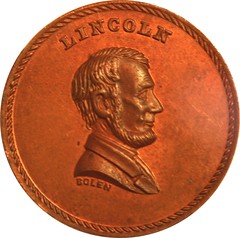
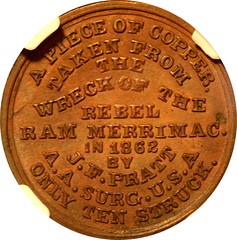
Dave writes:
My most interesting purchase at the recent ANA convention is a relic medal made of “A piece of copper taken from the wreck of the rebel ram Merrimac in 1862 by J. F. Pratt, A. A. Surg. U. S. A.,” pictures of which are attached. In my opinion this is one of the most desirable of all numismatic “relic” items.
This piece was brought to the attention of numismatists in the August 1868 issue of the American Journal of Numismatics when it was announced that “Through our friend Mr. J. A. Bolen of Springfield, Mass. we have received an impression of the above medalet as a donation to the society from Dr. J. F. Pratt, whom, as the society is now adjourned, we heartily thank in its behalf. The Doctor has four for sale at Two Dollars each. This memorial originated in the following way. Dr. Pratt having written to Mr. Bolen that he had such a piece of copper, the latter suggested that this use should be made of it. Being authorized to do so, he struck ten impressions only, and then defaced the reverse die, sending the Doctor the die and all the impressions except one. It is an interesting example of ‘Historic Material.'”
Neil Musante, in his comprehensive work, The Medallic Work of John Adams Bolen, (which I believe is still available from Charlie Davis) notes that Dr. Pratt donated one specimen to the New England Numismatic and Archaeological Society. There is also an example in the American Numismatic Society. Musante only found record of one nineteenth century sale, and two in the twentieth century.
I talked with Tom about several topics including The E-Sylum, his research on foreign coins used in early America, and photo-cropping software. He recommended free software called Photoscape that allows you to crop pictures in circles, a handy feature for manipulating coin images. It can be obtained from http://www.photoscape.org/ps/main/index.php. I usually use the free editor bundled with our Flickr photo archive, but it doesn't handle circular cropping. I tried it out on the above images of Dave'sBolen medal, and it worked nicely, even though it too me a few minutes to first figure out the program's interface.
Tom can always be counted on to pass around a neat group of interesting numismatic items at our meetings. One item which caught my eye was another relic medal. This one was made from silver recovered from Vigo bay wreck.

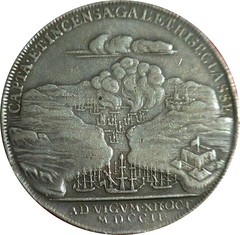
Tom writes:
This is an example of a silver half crown sized medal by John Croker, Betts #97, commemorating a victory won on October 12, 1702. Queen Anne with love-lock and brooch is on the obverse; Vigo Bay with French and Spanish fleets burning, the English fleet having captured “Spanish American treasure” on the reverse. It may be presumed this medal was made from booty, as were English coins in 1703 marked “Vigo” to denote the captured silver war prize.
In other conversation with Tom we discussed Eric Newman's research into James Audubon's grouse image and another "numismatic grouse", the 1665 Henry Fairfax medal. See Tom's query in the following item in this issue.
Gene had a nice group of six Hard Times Tokens, including Low numbers 4, 16 and 23. All were ex-Elvira Clain-Stefanelli. Low 4 has legends including "My Substitute for the U.S. Bank. Down with the Bank". The token includes images of a donkey and running boar. Gene had joked that the tokens were worth "at least five dollars apiece". I returned the joke, offering ten dollars for Low-4 so I could give it to my son Tyler, who collects coins with animals on them.
Others gradually arrived. It was great to see Traci Poole, who was back in town after relocating to Idaho. She brought me a present from the ANA convention - my certificate for editing The E-Sylum, which was voted the 2nd Best Numismatic Electronic Publication for 2010.
Dave Schenkman remarked, "If The E-Sylum is number two, what was number one?" I didn't know, although by now the answer may be on the ANA web site. He said "The archive alone is a treasure."
Also in attendance were Wayne Herndon, Bill and Susan Eckberg, Joe Levine and Mike Packard. Joe proposed a topic for E-Sylum readers - compiling a list of "The Worst Numismatic Books Ever Written" (by deceased authors only, please).
I could write more, but I'm running out of time so I'll stop here. It may have just been the wine Gene and I were drinking, but it was one of the most enjoyable dinners I can recall having - a wonderful group of folks and some great numismatic conversation.
ANOTHER “GROUSE HUNT”: 1665 HENRY FAIRFAX MEDAL SOUGHT
The story of Eric Newman's “grouse hunt” to flush out broken bank notes of New Jersey with John J. Audubon's first published drawing as mentioned in 1824 in his personnel journal, but lost to history until Eric went looking, inspires us to hunt new “numismatic grouse.”
The collection of the late C. Wyllys Betts documented by William Marvin and Lyman Low in 1894 describes early medals with connection to America. Perhaps less famous in a numismatic sense than the American proprietors Lord Baltimore or Cecil Calvert, Betts #43 describes a medal circa 1665 honoring Henry Fairfax, the fourth Lord Fairfax, who emigrated to America. Fairfax County, Virginia, later formed in 1749, from old Henry's land grant passing down his lineage.
On the obverse are the legend “HENRY FAYRFAX” with shield and arms of Fairfax and a crescent indicating a second son. The reverse shows a lion's head erased on a wreath; scroll border, size 24.
An electrotype is in the British Museum with the original not known to Betts, Marvin or Low. Do E-Sylum readers know if any originals survive having turned up since Betts “American Colonial History Illustrated by Contemporary Medals” was published?
To read the earlier E-Sylum article, see: ERIC NEWMAN DISCOVERS AUDUBON'S FIRST ENGRAVED ILLUSTRATION (www.coinbooks.org/esylum_v13n31a07.html)
THE BOOK BAZARRE
ARTICLE PROFILES U.S. MINT ARTIST SUSAN GAMBLE
 You may not know who artist Susan Gamble is, but chances are you have one of her drawings.
You may not know who artist Susan Gamble is, but chances are you have one of her drawings.
And you're carrying it in your pocket.
Gamble, who lives in New Braunfels, is one of five master designers in the country whose renderings are used as artwork on coins for the U.S. Mint.
She drew the leaping salmon in front of Mount Rainier for the Washington state quarter, the grizzly bear catching a salmon for the Alaska state quarter and the scissor-tailed flycatcher soaring over Indian blanket wildflowers for the Oklahoma state quarter.
Her drawings aren't limited to coin designs, either. Gamble has lent her talents to the U.S. Air Force, designing its first Air Force Combat Action Medal. The medal was created to recognize Air Force members who engage in air or ground combat, according to the service. The first six medals were awarded on June 12, 2007.
"The beauty is it was my gift to the Air Force that's been a big part of my life," Gamble said.
Gamble, whose husband, Mike, is a retired Air Force colonel, said she never thought her design would be selected for a medal. She said she simply was helping her husband with ideas to present to the Pentagon, and the Institute of Heraldry at Fort Belvoir adopted her suggestion with minor changes.
"They saw it and they liked it," she said. "I think maybe because I was a coin designer for the U.S. Mint, they felt like that gave me some credibility."
The medal is the only one for the U.S. military to have a diagonally patterned ribbon and features an eagle emblem in an Art Deco style. The eagle faces its right, where its talon is clutching arrows, reflecting preparedness for war. The left talon holds an olive branch.
Gamble said the emblem resembles the insignia used on the aircraft of Gen. Billy Mitchell, regarded as the father of the U.S. Air Force and who coordinated history's first air-to-ground offensive during World War I.
Gamble, 53, began drawing for the U.S. Mint in 2004, after being selected by the agency for its Artistic Infusion Program. The mint asked artists to apply for the program in 2003, and 27 were selected out of about 300 applicants.
Back then, Gamble was in Oklahoma City and had started to dedicate herself full time to her private business, Gamble Graphics, which she continues to operate out of her home with her son.
Gamble said she is one of four artists from that initial group who continue to design coins. Since then, one other artist has risen to the level of master designer.
To read the complete article, see:
Artist from New Braunfels does coin design
(www.timesrecordnews.com/news/2010/aug/19/
artist-new-braunfels-does-coin-design/)
DEALER FENTON RECOVERS COIN STOLEN TEN YEARS AGO
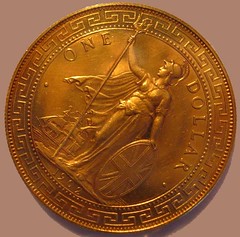 It was nearly ten years ago when prominent British coin dealer Stephen Fenton of Knightsbridge Coins purchased five rare coins at a Sotheby's auction in New York. Post-sale, Fenton entrusted FedEx to ship the coins overnight, and as promised, the box arrived next day at Knightsbridge Coins in London.
It was nearly ten years ago when prominent British coin dealer Stephen Fenton of Knightsbridge Coins purchased five rare coins at a Sotheby's auction in New York. Post-sale, Fenton entrusted FedEx to ship the coins overnight, and as promised, the box arrived next day at Knightsbridge Coins in London.
Imagine Fenton's surprise when he opened the package to find it stuffed full of white packing paper but no coins. Law enforcement and FedEx officials were immediately notified. Investigators later determined that the coins had never left the U.S., on the basis that the green-and-white striped tape used to reseal the box after it was looted was exclusively used at Newark Airport's FedEx warehouse in New Jersey.
Though police questioned a former FedEx employee, the thief was never caught. Fenton proceeded to register all five coins on the Art Loss Register's international database of stolen and missing art, a resource that champions due diligence checks prior to good faith purchases of artworks and decorative objects.
A decade later, three of the five looted coins appeared at auction-a German East Africa, 15 Rupien Coin (1916), a 16 Japanese, Mutsuhito, 1867-1912, 20 Yen Coin, gold, Meiji 3 (1870) and a British Colonial Proof Trade Dollar Coin, struck in gold (1902). Today, the three coins are collectively valued at over £30,000 GBP. Fenton enlisted in the ALR to contact the three auction houses involved, and the coins were pulled from their respective sales. Another major coin dealer from the United States who had consigned all three lots, claimed he had purchased the coins in good faith from another dealer.
With the help of Detective Robert Medaglia of the Port Authority of New York and New Jersey Police (whose name in Italian translates to "coin"), the case was reopened and a release was negotiated with the consignor by Christopher A. Marinello, General Counsel for the ALR. The coins were returned to Fenton by the ALR on behalf of his insurer.
"Everyone's entitled to a second chance," says Marinello. "When it came time to ship the coins from New York law enforcement back to London, we decided to use FedEx." The box arrived safely in London-this time, with its valuable contents inside.
Case Note: The ALR continues to actively look for the two missing coins, a Henry VIII, 1509-1547, Testoon and a Charles I 1625-1649, Newark Besieged, half. If you have any information or inquires as to their whereabouts, please contact the ALR at info@artloss.com or by calling +44 (0)207 841 5780.
To read the complete article, see: Art Loss Register Recovers Three High-Value, Historic Coins (www.artdaily.org/index.asp?int_sec=2&int_new=40058)
ARTICLE PROFILES 1881 CHOW BENT BATTLE MEDAL AWARDEE
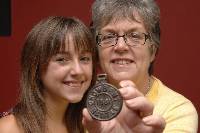 This rare medal is close to Frances Wilcock's heart.
This rare medal is close to Frances Wilcock's heart.
Frances, 63, has two medals given to her great grandfather John Unsworth for his role in 'The Battle of Howe Bridge' in 1881.
The famous incident saw a mass protest of local miners following a strike to protect the rights of workers injured in the pit.
Striking miners from other areas marched to Atherton to join the protest against those who crossed the picket line.
Fletcher Burrows workers, who decided not to join the strike, had to be protected by troops and magistrates close to the bridge over Colliers Brook, in Leigh Road in the town.
Mrs Wilcock, of Manor Grove, Leigh, has the medal awarded to her great-grandfather by his fellow miners after he helped to prevent the authorities from catching them.
She said: "My great-grandfather was one of the first miners to reach long meadow that day, when he was hotly pursued by the military.
"He held the field gate open to allow the miners to pass, and then closed it on the military thus allowing the miners to get away. For this action he was later presented with a medal.
"One one side are the words "Chow Bent Battle 1881" and on the reverse is the Royal Coat of Arms, which was ironic as they were fighting the Queen's men."
To read the complete article, see:
Frances shows off piece of history
(www.leighreporter.co.uk/leigh-news/Frances
-shows-off-piece-of.6481374.jp)
FEATURED WEB SITE: SYCEE ON-LINE
This week's Featured Web Site is Sycee On-Line, "Explorer to The World of Ancient China's Silver Treasure". It was suggested by Tom Kays. Thanks!

After a thousand years of circulation, it would seem to be a natural evolution for the shape, weight, and quality of a currency to become streamlined, simplified, and unified. The Chinese silver ingot currency's development, however, was in the opposite direction. It began with the Tang Dynasty's 50 tael rectangular bar and the Sung's axed ends and waisted ingots in 50 taels, 25 taels and 12.5 taels, then proceeded to the Yuan's ingots with their own characteristic shape.
During the Ming, the rims at the ends began to stand up and appear as ears or wings to create the form a preliminary Boat. Later in the Ching Dynasty, in addition to the traditional Boat shape, more distinct varieties of sycee were created, such as Drum, Groove, Square, Trough, Waist, Round, and Saddle; even the Boat shape underwent further evolution as can be seen with varieties like Big-winged and Tortoise.
Each time a silver pattern changed, it became more complicated and more difficult to handle. The casting process of each new silver pattern always required more skill and workmanship, and the entire silver currency system needed more people involved in weighing and assaying. While it kept many people employed, the system also made using silver more and more inconvenient and expensive. Gradually, Chinese silver ingots were replaced by foreign silver coins, and from 1890, Chinese machine struck silver coins began to circulate.
Eventually, China demonetized all silver taels in 1933. Most of the silver ingots in China then were melted down for coining silver dollars.
www.sycee-on-line.com
